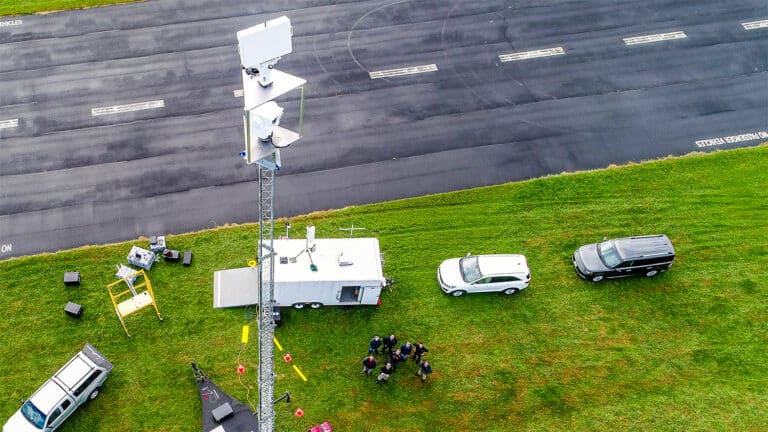This Tiny Orange Drone is Learning to Fly Blind, Ciao GPS!

We’ve all felt that tiny moment of panic. You’re flying, lining up the perfect shot, and for a split second, the GPS signal on your controller flickers. For us, it’s an annoyance. For the U.S. Air Force, it’s a critical vulnerability that could cripple their multi-million dollar aircraft.
Now, a small, unassuming drone that looks like an orange dart and sounds like a garden tool is at the heart of the solution. The Osprey MK III is a pint-sized testbed for a revolutionary idea: teaching drones to navigate in the dark, without any GPS at all. This little guy’s mission could change everything, not just for the military, but for every droner out there.

Meet the 50-Pound Genius
So, what is this little marvel? The Osprey MK III is a 7-foot-long, 50-pound drone that looks more like a hobbyist’s project than a cutting-edge military asset. On August 15, it completed its first autonomous test flight at Eglin Air Force Base, Florida, flying a successful mission with no GPS input whatsoever.

This drone is the star of a program called the “Autonomy, Data, and AI Experimentation Proving Ground.” That’s a mouthful, but the concept is simple: create a cheap, reliable way for small businesses and startups to test their big ideas. Instead of needing to integrate their software with a massive, expensive C-17 cargo plane, they can plug their “black box” of tech into the Osprey and let it fly. It dramatically lowers the barrier to entry for innovation, and as Lt. Col. Jonathan Gilbert of AFWERX said, it creates a “replicable experimental approach” for the brightest minds to test their tech in the real world.
The Ancient Art of Flying Without Satellites
GPS is a modern miracle, but it’s a fragile one. As we’ve seen in conflicts like Ukraine and in the Baltic Sea, enemy forces have become experts at jamming (blasting signals with noise) and spoofing (tricking a receiver with false data). So, how does the Air Force plan to fly when the satellites go silent? By looking to the past.

The Osprey is testing a suite of incredible navigation technologies:
- MagNav (Magnetic Navigation): This is the star of the show. It uses hyper-sensitive sensors to read the Earth’s natural magnetic field. Just like a fingerprint, this field has unique contours and anomalies. The drone compares its real-time readings to a pre-loaded magnetic map to know exactly where it is.
- Signals of Opportunity: The air is full of signals that aren’t GPS—TV broadcasts, radio stations, cell towers. This tech uses these ambient signals as a secondary grid to determine its position.
- Visual Navigation: Using cameras and advanced AI, the drone looks at the ground, recognizes landmarks, and compares them to satellite imagery in its memory to navigate, just like a human pilot would.
By layering these systems, the Air Force is creating a navigation “shield” that is nearly impossible to break. If GPS is jammed, MagNav takes over. If MagNav is confused, visual nav kicks in.
From Garden Tool to Game Changer
Yes, the Osprey’s little engine buzzes like a weed whacker, but don’t let the sound fool you. This drone is revolutionizing how a military superpower develops technology. By making testing faster, cheaper, and more accessible, it accelerates the timeline for getting this critical tech into the field.

A C-17 transport plane already proved it could fly across the country using MagNav as its primary navigation back in 2023. The Osprey’s role is to let dozens of other companies refine and perfect that technology without the billion-dollar price tag. This means jam-proof navigation will roll out faster, not just for massive warplanes, but for everything down the chain. That’s great news for the military, but it’s even better news for us.
The DroneXL Take
From here watching this story unfold is just fascinating. For years, I’ve been teaching pilots how to handle a GPS signal loss, and it’s one of the most stressful situations you can face. The idea of a drone that simply doesn’t care if GPS is there or not? That’s the holy grail.
What I love most about this is the sheer cleverness of the approach. The Air Force is solving one of its most complex problems by using a cheap, simple, orange drone. It’s a beautifully pragmatic solution. But “real talk,” as a tech guy, I know this isn’t easy. Trying to filter out the magnetic noise from a plane’s own electronics to get a clean MagNav reading is an insane technical challenge. It’s like trying to hear a pin drop during a rock concert.
Still, the potential here is what gets me excited. This isn’t just military tech. This is the future of all drones. Imagine your DJI Mavic losing signal in a remote canyon but still knowing its way home by reading the magnetic signature of the rocks below. Or navigating perfectly between skyscrapers by using TV signals instead of weak satellite links. This is the technology that will lead to truly autonomous, truly reliable drones for everyone.
This little orange weed whacker isn’t just a military test drone. It’s a pioneer, paving the way for a smarter, safer, and more resilient sky for all of us.
Photographs courtesy of Defense Visual Information Distribution Service
Discover more from DroneXL.co
Subscribe to get the latest posts sent to your email.
Check out our Classic Line of T-Shirts, Polos, Hoodies and more in our new store today!

MAKE YOUR VOICE HEARD
Proposed legislation threatens your ability to use drones for fun, work, and safety. The Drone Advocacy Alliance is fighting to ensure your voice is heard in these critical policy discussions.Join us and tell your elected officials to protect your right to fly.
Get your Part 107 Certificate
Pass the Part 107 test and take to the skies with the Pilot Institute. We have helped thousands of people become airplane and commercial drone pilots. Our courses are designed by industry experts to help you pass FAA tests and achieve your dreams.

Copyright © DroneXL.co 2025. All rights reserved. The content, images, and intellectual property on this website are protected by copyright law. Reproduction or distribution of any material without prior written permission from DroneXL.co is strictly prohibited. For permissions and inquiries, please contact us first. DroneXL.co is a proud partner of the Drone Advocacy Alliance. Be sure to check out DroneXL's sister site, EVXL.co, for all the latest news on electric vehicles.
FTC: DroneXL.co is an Amazon Associate and uses affiliate links that can generate income from qualifying purchases. We do not sell, share, rent out, or spam your email.


















